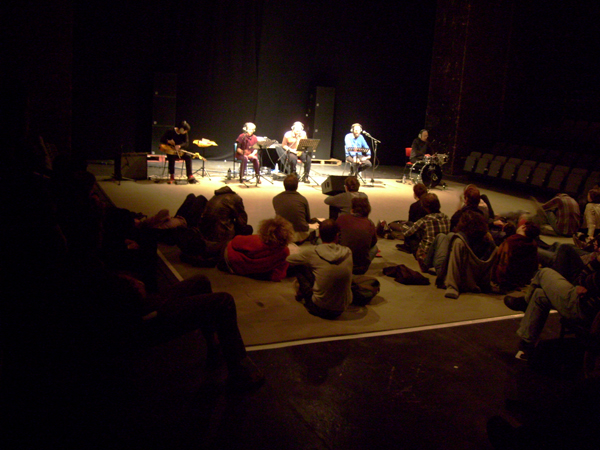

Graphic Score (version1)

SET UP
The composition follows a few simple principles that are shared by everybody. There are 2 talkers (Gael & Aileen) and 3 musicians (Seijiro, Neil, & Lucio). The set up "on stage" consists in these 5 “performers” (on a straight line) facing the audience.
They all use a headphone. Each headphone, connected to the mixing board, diffuse the same sound composition mixed with sounds produced by performer.
So that there are 5 different mixes, one for each performer (like 5 different fold back).
The 5 performers listen to 4 compositions, one after the other. Those compositions were done by jean-luc & eric in Glasgow last may. House 1 – 2 – 3 – 4 are the title (please refer to the following page : House installation).
The audience can’t hear those 4 original compositions (except short parts diffused in the stereo), that means parts of the final sound that the audience is listening to is a mix between what happens on stage and what is diffused from the mixing desk.
The 2 talkers' voices are diffused on two loudspeakers, one for each, in the middle of stage.
The 3 musicians are diffused on a powerfull stereo
The 5 performers are amplified.
The 3 musicians and the 2 talkers have to imitate what they ear in the headphone. Each one of them has a different agenda, an individual role in the final result and no one is controlling the final result.
The interpreters
Aileen Campbell (voice 2)
Lucio Capece (saxophone)
Neil Davidson (guitar)
Gael Leveugle (voice 1)
Seijiro Murayama (snare drum)
The Composition
Neither ironical nor cynical, this work is about being as precise as possible in the interpretation / transformation / imitation of the four original pieces
The imitation has to follow the precise timing, the sound level, and the specific rules of each performer. Those rules have to do with personal estimations (share of the cake !) :
- Seijiro (snare drum) has to imitate what he estimates to be an event, a tempo, a rhythm, or one interval.
- Gael (voice) has to estimate what is a significant word or a group of sounds producing a language.
- Aileen has to estimate the whole situation of the recording and then to describe and to comment this situation (space, architecture, the house, what people, the colours, what does it smell like ?...)
- Lucio (soprano saxophone) has to imitate what he estimates to be pitches into the composition.
- Neil (electic guitar) has to imitate what he estimates to be the rates of noise (in opposition to signal). There are 30 secondes of complete silence between each composition.
Each performer will have his or her own particular rule.
Review by Richard Pinnell (http://www.thewatchfulear.com/?p=4228) November 15th
Before this last section of the festival there had been a number of other performances, three of which really leapt out at me as inspiring, thoughtful and all three also very humorous events. Jean-Luc Guionnet and Eric La Casa took their House project, which had begun at Arika’s Uninstal project back in May to its next stage. House had seen the pair go to four people’s homes in Glasgow that they did not already know, and record elements of their houses, before asking the people living there to describe the places, and talk about their favourite music as it played on home stereos. I had really enjoyed the work back in May, which had been presented as a series of four audio installations at Tramway, each made in one of the homes. For this update, named House – the Tipping Point, four musicians (Neil Davidson on guitar, Lucio Capece, sax and Seijiro Murayama on percussion) plus two speaking parts (Glasgow vocalist Aileen Campbell and the French actor Gael Leveugle) all sat on stage listening to the House recordings on headphones. They then all responded to what they could hear, the musicians copying sounds they heard via their instruments, Campbell trying to describe what she thought the homes looked, smelt and felt like from the audio recordings, and Leveugle (quite brilliantly) tried to recreate the parts of the home owners, taking on their characters and repeating their words. For the most of the time, in the hall, we the audience could not hear the original recordings that the musicians could hear. So we got a fantastically accurate but also wonderfully evocative and thoughtful, perhaps even theatrical and frequently hilarious replay of the recordings. Occasionally La Casa and Guionnet would bring the audio up in the hall as well, so juxtaposing it against the live rendition. This was a really charming, elegant work that attempted to remove the composers from the way the project sounded, allowing a kind of sonic portrait to develop using separate parts that were not aware of each other. I found this a really thoughtful, intelligent idea.
HOUSE installation (first part of the project)